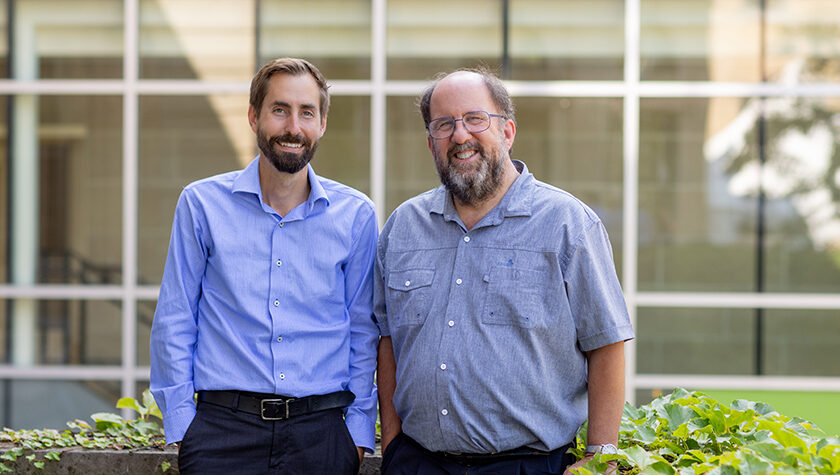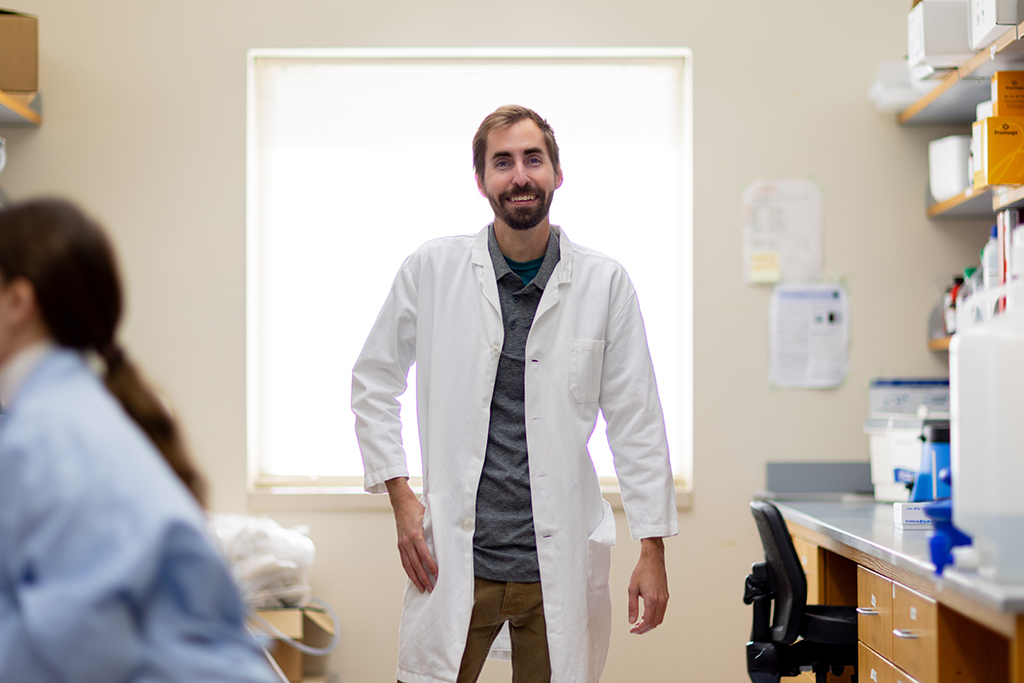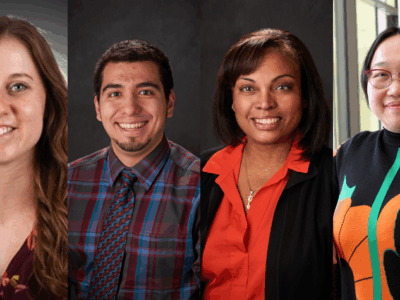
9
September

With an influx of federal aid, two School of Pharmacy professors will empower Wisconsin pharmacies with new tools to prevent opioid deaths
By Archer Parquette
Every year, more than 80,000 people in the United States die from opioid overdoses. Nearly 1,500 of them are in Wisconsin — more than four deaths each day.
“Losing these lives isn’t acceptable in a healthy society,” says Cody Wenthur, an associate professor in the University of Wisconsin–Madison School of Pharmacy’s Pharmacy Practice and Translational Research Division. “We don’t have the luxury to do nothing.”
Wenthur and Jay Ford, associate professor in the School’s Social and Administrative Sciences Division, are fighting to bring those numbers down. The two are leading the launch of the Wisconsin Opioid Overdose Response Center, or WOORC. The regional center, to be based at the School of Pharmacy, will combat the opioid crisis with a special focus on fentanyl, which accounts for over 75% of annual opioid overdose deaths. In March, the U.S. Senate approved a $2 million appropriations request as part of the fiscal year 2024 appropriations package to fund the launch of the center.
“My hope is that five years from now this center will be seen not only as a resource within Wisconsin, but that we will be nationally recognized as the place to go for pharmacists who want to make a direct impact in community health.”
—Jay Ford
“The Wisconsin Opioid Overdose Response Center is a true Wisconsin Idea initiative, leveraging the expertise of renowned School of Pharmacy faculty to improve and save lives in every corner of our state, even beyond,” says Steve Swanson, dean of the UW–Madison School of Pharmacy. “The federal appropriation to help launch this center emphasizes the gravity of what we already know is a very important issue.”
Between October 2024 and September 2025, Ford and Wenthur will be getting WOORC up and running so it can begin to provide community pharmacies around Wisconsin resources including educational information on treating overdoses, life-saving naloxone and fentanyl testing strips.
“My hope is that five years from now this center will be seen not only as a resource within Wisconsin, but that we will be nationally recognized as the place to go for pharmacists who want to make a direct impact in community health,” Ford says. “Wisconsin can be that national leader using community pharmacies to address the opioid epidemic.”
Studying opioids for public health
While Wenthur and Ford have lofty goals for the center, the project had unassuming beginnings — a brunch. The two pharmacy professors were invited to a meal at the Wisconsin Institute for Discovery with UW’s director of federal relations at the time, and other faculty members from the School of Pharmacy.

Both Wenthur and Ford have decades of overlapping experience researching opioids. Ford explores ways to improve treatments for substance use disorder and expand access through community pharmacies. Wenthur’s research touches on similar fields, including assessing barriers to addiction treatment and studying the effects of psychoactive substances like opioids.
Shortly after that brunch, they were invited to prepare a proposal for local, state and national representatives with potential ideas and solutions. Seeing an opportunity to expand the scope of their research and fight a worsening crisis, they both quickly said yes.
“First, we thought, ‘What can we do to hit the ground running and make a real impact?’” says Wenthur. “From there, we were off to the races.”
In March, Sen. Tammy Baldwin made the appropriations request and secured a one-time $2 million grant to launch the center with the passing of the appropriations package.
“She helped us champion this as an important area for public health,” says Wenthur.
Finding solutions
Now the work has just begun.
“It’s going to be a 365-day marathon,” says Ford. “The infrastructure is there — now we have to put it all together and deploy it.”
Wisconsin’s more than 800 community pharmacies are the cornerstone of Wenthur and Ford’s vision for WOORC. They will reach out to and support community pharmacies around the region, getting much-needed tools into both urban and rural parts of Wisconsin.
“There are large areas of the state that are underserved with regard to health care access, and particularly mental health care access,” says Wenthur. “That’s one of the reasons we are so excited about community pharmacies as a way to address this problem — community pharmacy is the most accessible health care resource. Clinics may be hours away, but pharmacies are there, ready and willing to serve. And that’s not unique to Wisconsin.”
The central aim for WOORC is to use pharmacies to increase patient access to treatments for opioid use disorder and opioid overdoses.
“By putting the focus and emphasis on the community pharmacy, we’re increasing the likelihood that these solutions will be sustainable because the pharmacies are already embedded in the community,” Ford says. “Through WOORC, we’ll just be expanding pharmacists’ toolkit to address opioid-related issues.”

To do so, WOORC will coordinate an initiative to save more lives with naloxone, which rapidly reverses the physical effects of an opioid overdose. Pharmacists screen patients for factors that could increase their risk of overdose — such as alcohol use, history of substance misuse, or use of benzodiazepines, which are often prescribed to treat anxiety, seizures, and muscle spasms. In those cases, the pharmacist could dispense naloxone alongside their opioid prescription to use in case of emergency.
“As medical professionals, pharmacists are trusted to serve their patients and address their needs confidentially, especially regarding stigmatized issues,” says Wenthur.
Another intervention is training pharmacists to provide long-acting injectable medications for opioid use disorders. For example, injections of naltrexone block the effects of opioid medications, including the pain relief and euphoric feelings that often lead to abuse.
They also developed solutions specifically tailored for the fentanyl crisis, including expanded access to fentanyl test strips.
“Unlike someone getting a prescription for oxycodone, many people being exposed to fentanyl don’t even know that they’re being exposed,” Wenthur says. The synthetic opioid is often laced in illicit drugs and counterfeit prescription medications sold illegally.
Wenthur and Ford are also planning public education about the risks of fentanyl contamination in drugs and using naloxone to treat fentanyl overdoses, which can be far more severe than other opioid overdoses.
“As we put this center together, I’m excited to create a circle that can lift each other up, help one another, and create new opportunities to make an impact in community health.”
—Cody Wenthur
“My nephew works as a paramedic in the EMS service,” Ford says. “One shot of naloxone doesn’t do it for fentanyl overdoses. He’s often using three, four, five, six — sometimes everything they have — to bring someone back.”
Wenthur’s realm of expertise adds another important longer-term aim for WOORC: to develop new anti-opioid vaccine formulations to help patients at risk for overdose. In such patients, the immune response triggered by the vaccine would reduce the “reward” the brain associates with opioids, lowering the drive to use.
Putting in the WOORC
WOORC will take advantage of the many experienced researchers and pharmacists at the School of Pharmacy, but Ford and Wenthur are looking far beyond Madison.
“The mandate for us is to get all around the state and engage with pharmacies in regions being particularly hard hit by the opioid crisis,” Wenthur says. “Ultimately, multiple parallel approaches are needed to address the massive scope opioid and fentanyl overdoses, and adding community pharmacy-focused programs like ours alongside direct public outreach efforts can give individuals several different choices and support structures to help meet them where they are at.”

They’re currently connecting with pharmacies and health care professionals across the state to help launch the center’s programs and initiatives, including a key partner: the Pharmacy Society of Wisconsin. The statewide organization representing pharmacists will support WOORC’s educational and communication goals, as well as extend their reach among Wisconsin practitioners.
They are establishing an advisory board with external subject matter experts on opioid misuse and overdosing and are connecting with a spate of Wisconsin agencies — such as the Wisconsin Department of Health, Rural Wisconsin Health Cooperative, and Wisconsin Psychiatric Association — to ensure they target the communities that would benefit most.
“We’re blessed here at the University of Wisconsin–Madison to have a very active and collaborative medical research community,” says Wenthur. “As we put this center together, I’m excited to create a circle that can lift each other up, help one another, and create new opportunities to make an impact in community health.”






